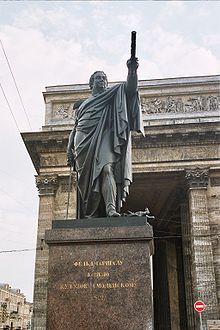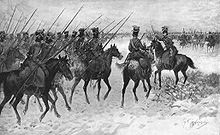- Order of battle of the French invasion of Russia
-
This is the order of battle of the French invasion of Russia.
Grande Armée
On June 24, 1812, the Grande Armée of 690,000 men, the largest army assembled up to that point in European history, crossed the river Neman and headed towards Moscow.
The Grande Armée was divided as follows:
Major Général (Chief of Staff) Maréchal Louis Alexandre Berthier, 1st Duc de Wagram, 1st Duc de Valengin, 1st Sovereign Prince de Neuchâtel
- Northern flank
- X Corps 32,500 (Pr, Po, Bv, We) Maréchal Etienne-Jacques-Joseph-Alexandre MacDonald, Duc de Tarente
- Southern flank
- VII Corps 17,000 (Sx) Général de division Jean-Louis-Ebénézer Reynier
- Austrian Corps 34,000 (Au) Feldmarschall Karl Philipp Fürst zu Schwarzenberg, Herzog von Krumau
- Central force of 250,000 under the Emperor's personal command (north to south).
- Imperial Guard 47,000 (Fr,Po,Du, He,Pr,Sw) Maréchal Jean-Baptiste Bessières Duc d'Istrie (cavalry of the Guard); Maréchal Pierre François Joseph Lefebvre Duc de Dantzig (Old Guard infantry); Maréchal Adolphe Edouard Casimir Joseph Mortier Duc de Trévise (Young Guard infantry)
- I Corps 72,000 (Fr,Ba,Me,Sp) Maréchal Louis Nicolas Davout, Duc d'Auerstaedt, Prince d'Eckmühl
- II Corps 37,000 (Fr,Sw,Cr,Pt) Maréchal Nicolas Charles Oudinot, Duc de Reggio
- III Corps 40,000 (Fr,Pt) Maréchal Michel Ney, duc d'Elchingen
- IV Corps 46,000 (It,Fr,Cr,Sp) Général de division Eugène Rose de Beauharnais, Prince Français, Prince of Venice, Viceroy of the Kingdom of Italy
- V Corps 36,000 (Po) Général de division Josef Antoni, Prince Poniatowski
- VI Corps 25,000 (Bv) Général de division Marquis Laurent de Gouvion-Saint-Cyr
- VIII Corps 18,000 (We,He) Général de division Jérôme-Napoléon Bonaparte, French Prince, King of Westphalia later Jean-Andoche Junot Duc d'Abrantès
- III Reserve Cavalry Corps 10,000 (Fr,Bv,Sx) Général de division Emmanuel, Marquis de Grouchy
- IV Reserve Cavalry Corps 8000 (Po,Sx,We) Général de division Marie-Charles-César de Faÿ, comte de la Tour-Maubourg
- I & II Reserve Cavalry Corps 22,000 (Fr,Po,Pr,Wu) Maréchal Joachim Murat, King of Naples
- I Reserve Cavalry Corps Général de division Compte de Nansouty
- II Reserve Cavalry Corps Général de division Compte Montbrun
- Reserve in Poland
- XI Corps 50,000 (Fr,It,Ge,Ne) Maréchal Pierre François Charles Augereau, Duc de Castiglione
- Reserve in Germany
- IX Corps 35,000 (Fr,Po,Bd,Ge,Be) Maréchal Claude-Victor Perrin, known as Victor, Duc de Bellune
Main article: List of French commanders in the Russian 1812 CampaignIn addition 80,000 National Guards had been conscripted for full military service defending the imperial frontier of the Duchy of Warsaw. With these included total French imperial forces on the Russian border and in Russia came to almost 800,000 men. This vast commitment of manpower severely strained the Empire — especially considering that there were a further 300,000 French troops fighting in Iberia and over 200,000 more in Germany and Italy.
The army consisted of:
- 300,000 troops from the French Empire[1]
- 10,000 Dutch from anexed Kingdom of Holland
- 10,000 Flemish and Waloons from anexed Belgium territories
- 10,000 Germans from anexed North Germany and left bank of the Rhine River
- 10,000 Italians from anexed Piedmont, Tuscany and Genoa
- 98,000 Poles[1]
- 119,000 Germans
- 29,000 Bavarians
- 21,000 Westphalians[1] (other German sources mention 28,000)[2]
- 20,000 Saxons
- 12,000 Württemberg
- 6,000 Baden[1]
- 5,000 Hesse[1]
- 4,000 Berg and Cleve
- 12,000 other members of Rhine Confederation
- 20,000 Prussians[1]
- 34,000 in the detached Austrian Corps under Schwarzenberg
- 23,000 Italians from Napoleonic Kingdom of Italy
- 8,000 Neapolitans
- 9,000 Swiss[1] (German sources[3] mention 16,000)
- 4,800 Spanish
- 3,500 Croats
- 2,000 Portuguese
Anthony Joes in Journal of Conflict Studies wrote that:
Figures on how many men Napoleon took into Russia and how many eventually came out vary rather widely.
- [Georges] Lefebvre says that Napoleon crossed the Neman with over 600,000 soldiers, only half of whom were from France, the others being mainly Germans and Poles.
- Felix Markham thinks that 450,000 crossed the Neman on 25 June 1812, of whom less than 40,000 recrossed in anything like a recognizable military formation.
- James Marshall-Cornwall says 510,000 Imperial troops entered Russia.
- Eugene Tarle believes that 420,000 crossed with Napoleon and 150,000 eventually followed, for a grand total of 570,000.
- Richard K. Riehn provides the following figures: 685,000 men marched into Russia in 1812, of whom around 355,000 were French; 31,000 soldiers marched out again in some sort of military formation, with perhaps another 35,000 stragglers, for a total of less than 70,000 known survivors.
M. Minard's infographic (see below) depicts the march ingeniously by showing the size of the advancing army, overlaid on a rough map, as well as the retreating soldiers together with temperatures recorded (as much as 30 below zero on the Réaumur scale) on their return. The numbers on this chart have 422,000 crossing the Neman with Napoleon, 22,000 taking a side trip early on in the campaign, 100,000 surviving the battles en route to Moscow and returning from there; only 4,000 survive the march back, to be joined by 6,000 that survived that initial 22,000 in the feint attack northward; in the end, only 10,000 cross the Neman back out of the initial 422,000.[5]
Adam Zamoyski estimated that between 550,000 and 600,000 French and allied troops (including reinforcements) operated beyond the Niemen, of which as many as 400,000 troops died.[6]
Russian Imperial Army
The forces immediately facing Napoleon consisted of three armies comprising 175,250 Russians and 15,000 Cossacks, with 938 guns as follows:
 Monument to Kutuzov in front of the Kazan Cathedral in Saint Petersburg. The Kazan Cathedral and the Cathedral of Christ the Saviour in Moscow were built to commemorate the Russian victory against Napoleon.
Monument to Kutuzov in front of the Kazan Cathedral in Saint Petersburg. The Kazan Cathedral and the Cathedral of Christ the Saviour in Moscow were built to commemorate the Russian victory against Napoleon.
General of Infantry Mikhail Bogdanovich Barclay de Tolly served as the Commander in Chief of the Russian Armies, a field commander of the First Western Army and Minister of War until replaced by Mikhail Illarionovich Kutuzov who assumed the role of Commander-in-chief during the retreat after the Battle of Smolensk.
- First Western Army under Emperor Alexander I with General of Infantry Mikhail Bogdanovich Barclay de Tolly as a field commander and Minister of War numbered 104,250 men and 7,000 Cossacks with 558 guns.[7]
- Chief of Staff General Lieutenant Aleksey Petrovich Yermolov
- II Infantry Corps General of Infantry Mikhail Andreyevich Miloradovich
- V Infantry Corps General Lieutenant Lavrov
- IV Infantry Corps General Lieutenant Alexander Ivanovich Ostermann-Tolstoy
- VI Infantry Corps General Lieutenant Dmitry Sergeyevich Dokhturov
- I Cavalry Corps General Lieutenant Uvarov
- II Cavalry Corps General Major Korff
- III Cavalry Corps General Major Kreutz
- Matvey Ivanovich Platov - Ataman of the Don Cossacks
- Second Western Army General of the Infantry Prince Pyotr Ivanovich Bagration numbered 33,000 men and 4,000 Cossacks with 216 guns.[7]
- III Infantry Corps General Lieutenant Tuchkov 1st
- VII Infantry Corps General Lieutenant Nikolay Nikolayevich Raevsky
- VIII Infantry Corps General Lieutenant Borosdin
- IV Cavalry Corps General Major von Sievers
- Third Reserve Army of Observation General of the Cavalry A.P.Tormasov numbered 38,000 men and 4,000 Cossacks, with 164 guns.[7]
- Danube Army Admiral Pavel Vasilievich Chichagov
- Prince Peter Khristianovich Wittgenstein — Commander of the Right Wing
- Riga corps (lieutenant general I.N.Essen 1st)
- Finnish corps (General Lieutenant F.F.Shteyngel)
- 1st reserve corps (General Adjutant baron E.I.Meller-Zakomelskiy)
- 2nd reserve corps (General Lieutenant F.F.Ertel)
- Bobruiskiy force (General Major G.A.Ignatev)
- Smolensk reserve corps(General Adjutant baron F.F.Wintsingerode)
- Kaluga reserve corps (General of the Infantry Of m.A.Miloradovich)
- 27th infantry division (General Major D.P.Neverovskiy)
- Force in Serbia (General Major N.I.Liders)
These forces, however, could count on reinforcements from the second line, which totaled 129,000 men and 8,000 Cossacks, with 434 guns and 433 rounds of ammo.
Of these about 105,000 men were actually available for the defense against the invasion. In the third line were the 36 recruit depots and militias, which came to the total of approximately 161,000 men of various and highly disparate military values, of which about 133,000 actually took part in the defense.
Thus, the grand total of all the forces was 488,000 men, of which about 428,000 gradually came into action against the Grand Army. This bottom line, however, includes more than 80,000 Cossacks and militiamen, as well as about 20,000 men who garrisoned the fortresses in the operational area.
Sweden, Russia's only ally, did not send supporting troops. But the alliance made it possible to withdraw the 45,000 man Russian corps Steinheil from Finland and use it in the later battles (20,000 men were sent to Riga).[8]
References
- ^ a b c d e f g Riehn, Richard K, p. 81.
- ^ according to the Landesmuseum in Westphalias former capital Kassel
- ^ Meyers Konversationslexikon 1888
- ^ Anthony James Joes. Continuity and Change in Guerrilla War: The Spanish and Afghan Cases, Journal of Conflict Sudies Vol. XVI No. 2, Fall 1997. Footnote 27, cites
- Georges Lefebvre, Napoleon from Tilsit to Waterloo (New York: Columbia University Press, 1969), vol. II, pp. 311–12.
- Felix Markham, Napoleon (New York: Mentor, 1963), pp. 190, 199.
- James Marshall-Cornwall: Napoleon as Military Commander (London: Batsford, 1967), p. 220.
- Eugene Tarle: Napoleon's Invasion of Russia 1812 (New York: Oxford University Press, 1942), p. 397.
- Richard K. Riehn See 1812: Napoleon's Russian Campaign (New York: John Wiley, 1991), pp. 77 and 501
- ^ See a large copy of the chart here, but discussed at length in Edward Tufte, The Visual Display of Quantitative Information (London: Graphics Press, 1992)
- ^ Zamoyski 2005, p. 536 — note this includes deaths of prisoners during captivity
- ^ a b c Riehn, Richard K, p. 88.
- ^ Helmert/Usczek: Europäische Befreiungskriege 1808 bis 1814/15, Berlin 1986
Categories: - Northern flank
Wikimedia Foundation. 2010.

